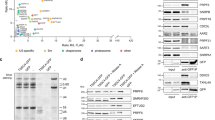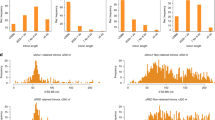Abstract
Pre-messenger-RNA maturation in nematodes and in several other lower eukaryotic phyla involves spliced leader (SL) addition trans-splicing1,2. In this unusual RNA processing reaction, a short common 5′ exon, the SL, is affixed to the 5′-most exon of multiple pre-mRNAs. The nematode SL is derived from a trans-splicing-specific ∼100-nucleotide RNA (SL RNA) that bears striking similarities to the cis-spliceosomal U small nuclear RNAs U1, U2, U4 and U5 (refs 3, 4); for example, the SL RNA functions only if it is assembled into an Sm small nuclear ribonucleoprotein (snRNP)5. Here we have purified and characterized the SL RNP and show that it contains two proteins (relative molecular masses 175,000 and 30,000 (Mr 175K and 30K)) in addition to core Sm proteins. Immunodepletion and reconstitution with recombinant proteins demonstrates that both proteins are essential for SL trans-splicing; however, neither protein is required either for conventional cis-splicing or for bimolecular (trans-) splicing of fragmented cis constructs. The Mr 175K and 30K SL RNP proteins are the first factors identified that are involved uniquely in SL trans-splicing. Several lines of evidence indicate that the SL RNP proteins function by participating in a trans-splicing specific network of protein–protein interactions analogous to the U1 snRNP–SF1/BBP–U2AF complex that comprises the cross-intron bridge in cis-splicing.
This is a preview of subscription content, access via your institution
Access options
Subscribe to this journal
Receive 51 print issues and online access
$199.00 per year
only $3.90 per issue
Buy this article
- Purchase on Springer Link
- Instant access to full article PDF
Prices may be subject to local taxes which are calculated during checkout



Similar content being viewed by others
References
Blumenthal, T. & Steward, K. in C. elegans II (ed. Priess, J. R.) 117–146 (Cold Spring Harbor Laboratory, Cold Spring Harbor, 1997)
Nilsen, T. W. in Frontiers in Molecular Biology: Eukaryotic mRNA Processing (ed. Krainer, A. R.) 310–334 (IRL, Oxford, 1997)
Bruzik, J. P., van Doren, K., Hirsh, D. & Steitz, J. A. Trans-splicing involves a novel form of small ribonucleoprotein particles. Nature 335, 559–562 (1988)
Thomas, J. D., Conrad, R. C. & Blumenthal, T. The C. elegans trans-spliced leader RNA is bound to Sm and has a trimethylguanosine cap. Cell 54, 533–539 (1988)
Maroney, P. A., Hannon, G. J., Denker, J. A. & Nilsen, T. W. The nematode spliced leader RNA participates in trans-splicing as an Sm snRNP. EMBO J. 9, 3667–3673 (1990)
Denker, J. A., Maroney, P. A., Yu, Y.-T., Kanost, R. A. & Nilsen, T. W. Multiple requirements for nematode spliced leader RNP function in trans-splicing. RNA 2, 746–755 (1996)
Chiara, M. D. & Reed, R. A two-step mechanism for 5′ and 3′ splice-site pairing. Nature 375, 510–513 (1995)
Bruzik, J. P. & Maniatis, T. Enhancer-dependent interaction between 5′ and 3′ splice sites in trans. Proc. Natl Acad. Sci. USA 92, 7056–7059 (1995)
Abovich, N. & Rosbash, M. Cross-intron bridging interactions in the yeast commitment complex are conserved in mammals. Cell 89, 403–412 (1997)
Hannon, G. J., Maroney, P. A. & Nilsen, T. W. U small nuclear ribonucleoprotein requirements for nematode cis- and trans-splicing in vitro. J. Biol. Chem. 266, 22792–22695 (1991)
Rain, J.-C., Rafi, Z., Rhani, Z., Legarin, P. & Krämer, A. Conservation of functional domains involved in RNA binding and protein–protein interactions in human and Saccharomyces cerevisiae pre-mRNA splicing factor SF1. RNA 4, 551–565 (1998)
Nilsen, T. W. Evolutionary origin(s) of SL-addition trans-splicing: Still an enigma. Trends Genet. 17, 678–680 (2001)
Stover, N. A. & Steele, R. E. Trans-spliced leader addition of mRNAs in a cnidarian. Proc. Natl Acad. Sci. USA 98, 5693–5698 (2001)
Davis, R. E. Spliced leader RNA trans-splicing in metazoa. Parasitol. Today 12, 33–40 (1996)
Makarova, O. V., Makarov, E. M. & Lührmann, R. The 65 and 110 kDa SR-related proteins of the U4/U6.U5 tri-snRNP are essential for the assembly of mature spliceosomes. EMBO J. 20, 2553–2563 (2001)
Maroney, P. A., Romfo, C. M. & Nilsen, T. W. Functional recognition of the 5′ splice site by U4/U6.U5 tri-snRNP defines a novel ATP-dependent step in early spliceosome assembly. Mol. Cell 6, 317–328 (2000)
Mazroui, R., Puoti, A. & Krämer, A. Splicing factor SF1 from Drosophila and Caenorhabditis: Presence of an N-terminal RS domain and requirement for viability. RNA 5, 1615–1631 (1999)
Acknowledgements
We thank J. Bruzik, J. A. Wise and M. Caprara for comments on the manuscript, and A. M. Micenmacher for help with figures and manuscript preparation. The work was supported by grants from the N.I.H.
Author information
Authors and Affiliations
Corresponding author
Ethics declarations
Competing interests
The authors declare that they have no competing financial interests
Supplementary information
Rights and permissions
About this article
Cite this article
Denker, J., Zuckerman, D., Maroney, P. et al. New components of the spliced leader RNP required for nematode trans-splicing. Nature 417, 667–670 (2002). https://doi.org/10.1038/nature00783
Received:
Accepted:
Issue Date:
DOI: https://doi.org/10.1038/nature00783
This article is cited by
-
On the Possibility of an Early Evolutionary Origin for the Spliced Leader Trans-Splicing
Journal of Molecular Evolution (2017)
-
A novel spliceosome-mediated trans-splicing can change our view on genome complexity of the divergent eukaryote Giardia intestinalis
Biophysical Reviews (2011)
-
Caenorhabditis elegans operons: form and function
Nature Reviews Genetics (2003)
Comments
By submitting a comment you agree to abide by our Terms and Community Guidelines. If you find something abusive or that does not comply with our terms or guidelines please flag it as inappropriate.



